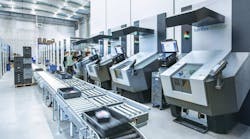In recent years, trusted and reliable stainless steel processing trains have found themselves in competition with newer plastic, sterility-assured, single-use options.
Often, the key factors for determining the best processing train are project-specific, meaning the decision must be made on a case-by-case basis. Stainless steel offer capacity for large-scale projects but many may not be able to achieve a quick project turnaround time. On the other hand, single-use trains provide immense flexibility but are heavily reliant on supply chains to source the single-use equipment and could impact project timelines if delays in the chain occur.
Ultimately, each option must be assessed in terms of the cost, the scale of the manufacturing project and the timeframe available. A third, hybrid option — working with contract development and manufacturing organizations (CDMOs) offering both types of processing trains — can provide biologic drug developers with distinct advantages at each stage of development and manufacturing.
Stainless steel vs. single-use
Before viable single-use systems were available at a commercial scale, stainless steel was the preferred processing train for most pharmaceutical projects, especially for large-scale biologics manufacturing. As a result, the industry’s application of stainless steel-based processing technologies is well understood and has precedent in large-scale, robust biologics manufacturing.
However, over time, single-use processing technologies have grown in scale, scope, and popularity. As they have matured, they have become more robust and well-understood by process engineers, leading to their use being considered more often.
Although operational excellence and process optimization can blur the cost of goods (CoG) curve and production timeline differences between stainless steel and single-use technologies, both can deliver unique pros as well as cons to biologics developers:
Single-use bioprocessing technologies
Positives
- Provide process flexibility: Due to the modular nature of systems, new upstream/downstream processing capacity can be added with relative ease.
- Accelerate Product Change Over (PCO) turnaround times: A primary advantage of single-use technology is that it takes less time to exchange single-use containers and recommission the train than it does to decontaminate and verify a dedicated stainless-steel process.
- Mitigate cross-contamination between projects: Removing single-use components after use and exchanging them with new ones minimizes the threat of cross-contamination.
Considerations
- Require extensive testing of extractables and leachables: This critical analysis may require support from third parties, adding to operating expenses and project costs.
- Depend heavily on well-managed supply chains: Without careful management of supply chains and an appropriate second source of materials, there can be a risk of delays to the project due to potential supply disruptions.
- Introduce operational complexity related to procurement and product flow: Single-use processes require concentrated dedicated resources for their management, spanning from purchase orders, to loading docks, to recycle bins.
- May offer a relatively higher operational expense load over time:
Despite inherent PCO efficiencies, single-use process costs are tied to supply and demand and are therefore vulnerable to sudden price increases that can negatively impact project economies and market returns over a product’s commercial life.
Stainless steel technologies
Positives
- Provide a reusable, repeatable, and compliant processing train: Stainless steel processing systems are well understood and, when dedicated to the molecule within a quality-by-design (QbD) framework, assure yield and product quality, especially at commercial scale.
- Sustain process robustness and reliability: Stainless steel systems are likely to be more stable operationally, as well as being less prone to variation or potential opportunities for deviation related to damage like pin-hole pricks.
- Shorten process and production timelines: Unlike in single-use systems, where all consumables must be tested before production can begin, the reusable nature of stainless steel means that tests for extractables and leachables will have already been performed. This can help to shorten project timelines.
- Allow for a simplified supply chain: With stainless steel systems, critical supply chains are less of a concern. Cleaning stainless steel systems has the potential to require few commodities and may only need decontaminating chemicals and water. Further closed clean-in-place (CIP) and sterilize-in-place (SIP) systems often recycle cleaning fluids for reuse, making delays due to supply chain issues less of a concern.
Considerations
- Require intensive expense commitments upfront: The capital costs of stainless steel-based processes are largely fixed and sunk. However, adding new additional capacity or establishing dedicated processing platforms to manufacture new molecules may require intensive financial commitment well before the first batch is released.
- Offer limited process optimization and flexibility: Dedicated stainless steel processes offer fewer opportunities to increase yield or capacity beyond the system’s original specifications, as they are inherently fixed after a certain point in engineering.
- Have vulnerability to cross-contamination and slower PCO: Both CIP and SIP operations take time to accomplish compliantly and can delay PCO timelines.
- Demand compliant decontaminating and recommissioning: CIP and SIP quality control is critical to ensure effective decontamination between batches and PCOs. Maintaining quality and keeping operations validated and compliant can be challenging and time-consuming, especially when it comes to documentation.
Ultimately the decision is project-dependent
The scale of the project
The nature of each project will ultimately determine the type of processing train that is best suited. Process scale and batch scale are critical factors when weighing the merits of system choices.
When product demand is sufficient to justify investing in industrial-scale processing capacity, stainless steel will likely offer better economies of scale and CoG efficiencies as compared with single-use trains.
End-to-end commercial processes are more likely to be stainless steel because the parameters are easier to establish and sustain over the long run – which justifies the capital expenditures (CapEx) and operational expenditures (OpEx).
However, trends in biopharmaceutical medicine and therapeutic development mean that the definition of “commercial scale” is changing. Emerging cell and gene therapies (C>s) for example only require so much capacity to produce at commercial levels – autologous therapies for example are manufactured at a scale of 1. The customizable and disposable nature of single-use systems often makes them better suited to control the high variability associated with C> processing and offer a faster PCO for these projects.
Batch scale is often relative to the clinical phase. Depending on where a biologic is in its development and regulatory approval process, single-use system modularity and flexibility may be better suited. For example, batches for late-phase I and later clinical trial supply are smaller and single-use systems’ quicker turn-around between batches and products can be markedly more cost-efficient in development than stainless steel.
Single-use is often used to achieve initial proof-of-concept and demonstrate drug efficacy at a small scale. However, stainless steel is often the more cost-effective choice on a large-scale. Therefore, it is important to carefully project potential markets and volumes before making any long-term financial and business decisions on the type of processing train to invest in.
The process types and parameters
Stainless steel-contained processes can accommodate a wider range of process types than single-use systems. However, the decision must be made case-by-case. For example, single-use processes can be ideal for typical cell culture processes, but difficult to apply for mass reactions or microbial processes.
The structure of stainless steel processing trains also means that they can physically and safely accommodate wider process parameters ranges and conditions when compared with single-use. For example, harsher raw materials can be used, higher temperatures and pressures can be handled, and higher mixing speeds can be achieved.
Leveraging both
Each type of processing train offers its own distinct process design advantages. It is also clear that depending on critical variables, one system may be better suited to one type of project more than another.
A hybrid strategy, where both single-use process equipment and stainless steel process equipment are used throughout development and manufacturing is a further option. Incorporating single-use technology into a predominantly stainless steel manufacturing infrastructure can offer flexibility and the combined benefits of both processing types.
Partnering with CDMOs that offer a hybrid approach gives the capability to tailor approaches and optimize them in line with process economies and quality goals. With both processing trains available, developers will also have greater latitude to explore process innovation and upstream/downstream process optimization strategies.
Stainless steel systems are likely to remain essential for many manufacturing projects, offering the most robust and reliable approach in larger-scale projects. However, the popularity and utility of single-use systems are likely to continue to grow along with technological advancements in emerging therapies and treatments. CDMOs that can offer both may be best placed to meet the needs of the diverse array of biologics in development both now and in the future.






